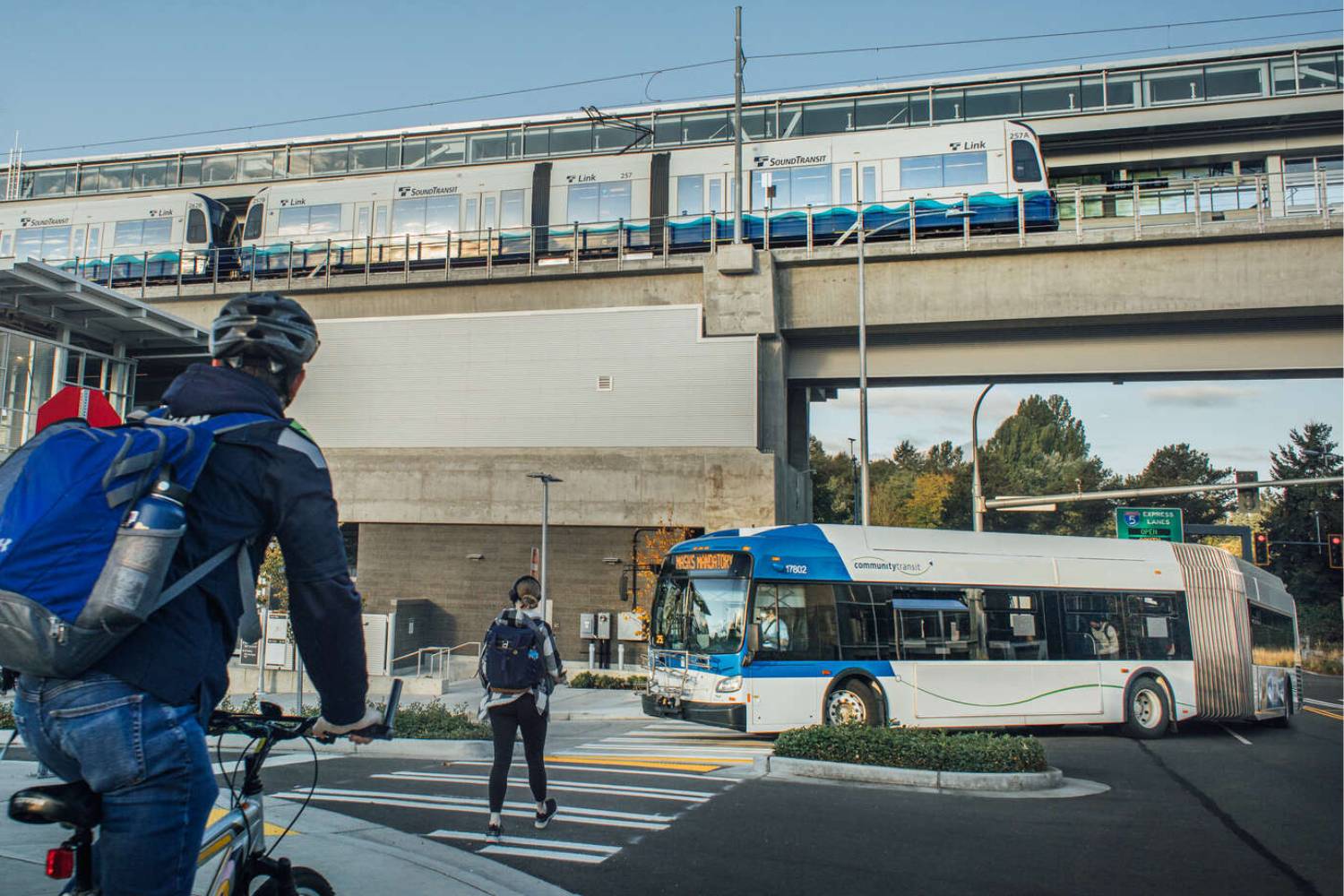
Transit transformation begins to take shape in 2024
2024 Budget and Long Range Plan set course for more transit options

Pictured above: There will be improvements to Community Transit’s bus service next year when light rail opens in Snohomish County.
The Community Transit Board of Directors today approved the agency’s 2024 budget and “Journey 2050,” the agency’s long range plan. This sets in motion major changes that will give people in Snohomish County more public transportation options than ever before.
“The population is growing and changing, so people need new options that fit their lifestyle. Starting next year, people in Snohomish County will be able to go more places — and get there faster — using public transportation,” said Community Transit CEO Ric Ilgenfritz. “Our plans address the near- and long-term needs of this community. And as we build a transit system for the future, we are looking to make it one that is sustainable for generations to come.”
BRT expansion — Swift Orange Line opens
Changes start on March 30, 2024 with the launch of a new bus rapid transit (BRT) line in south Snohomish County. The Swift Orange Line, Community Transit’s third BRT line, will connect to the existing Swift Blue Line and Swift Green Line to provide a network of fast, frequent bus service along major corridors. The Swift Orange Line will travel between Edmonds College and Mill Creek. Notably, it will make a stop at Lynnwood Transit Center, allowing people to easily connect to Link light rail and the other BRT lines when it opens next fall. People will also be able to easily connect to rideshare services from the Swift Orange Line, including Zip Alderwood Shuttle and Vanpool.
Frequent local service, connections to light rail
There will be more improvements to Community Transit’s service area later next year when light rail opens. This means there will be better local bus service in Snohomish County. These changes include new express bus connections to Link from most parts of the county, and higher frequency in local service, with buses running more often throughout the day and evening. All of these changes take into account major growth in the county, changing travel and commute patterns, and new regional transit options, such as light rail.
New innovative services and travel options
Community Transit also has plans to make travel easier by adding new types of transit services. The Innovative Services program is dedicated to finding ways to bridge the “first-mile, last-mile” challenge and address transportation gaps within communities. In 2024, Zip Alderwood Shuttle, an on-demand service, begins its first full year as a regular service. Similar services will be tested in Arlington, Darrington, and Lake Stevens next year. Planning for Innovative Service pilots in three additional communities will also begin. The Long Range Plan sets a goal of delivering Innovative Services for more communities throughout the county. These types of services make transit easier for everyone to access.
Planning for a better future
Looking further into the future, Community Transit is making plans now to reduce the agency’s impact on the environment by working to transition to zero emission buses. Zero emissions buses are quieter and cleaner than diesel-powered buses. In January 2024, a battery electric bus and a hydrogen fuel cell bus will be tested to inform future zero-emission bus and technology investments. The two test buses will be used on routes by mid-year. The Long Range Plan establishes a target of achieving a full transition to zero-emissions buses by 2044.
Safe service for everyone
Safety and security are top priorities and are key to ensuring people choose transit. 2024 marks the first full year of funding for the Transit Security Officer (TSO) program launched in 2023. TSOs enforce the agency’s Rules of Conduct and maintain a steady presence to deter unwanted and illegal behavior. TSOs work closely with Community Transit’s Service Ambassadors and Transit Police Unit. The agency will also continue to contract with the Snohomish County Sherriff’s Office to employ dedicated transit police and a social worker who is trained to work with people experiencing crises.
About “Journey 2050”
The Long Range Plan provides a long-term vision for transit service in Snohomish County. Community Transit’s first Long Range Plan, adopted in 2011, has served as a guide to near-term planning efforts, allowed the agency to respond to initiatives such as Sound Transit’s Link light rail extension to Snohomish County, and has been instrumental in coordinated multi-modal planning efforts among jurisdictions in Snohomish County.
The Journey 2050 Long Range Plan update extends the horizon of the Long Range Plan to 2050, provides an updated vision for transit service, and identifies capital and financial needs in order to support the 2050 transit service vision. Journey 2050 was developed with community input in alignment with Puget Sound Regional Council's (PSRC) Vision 2050 plan, which serves as a guide for growth in the region.

